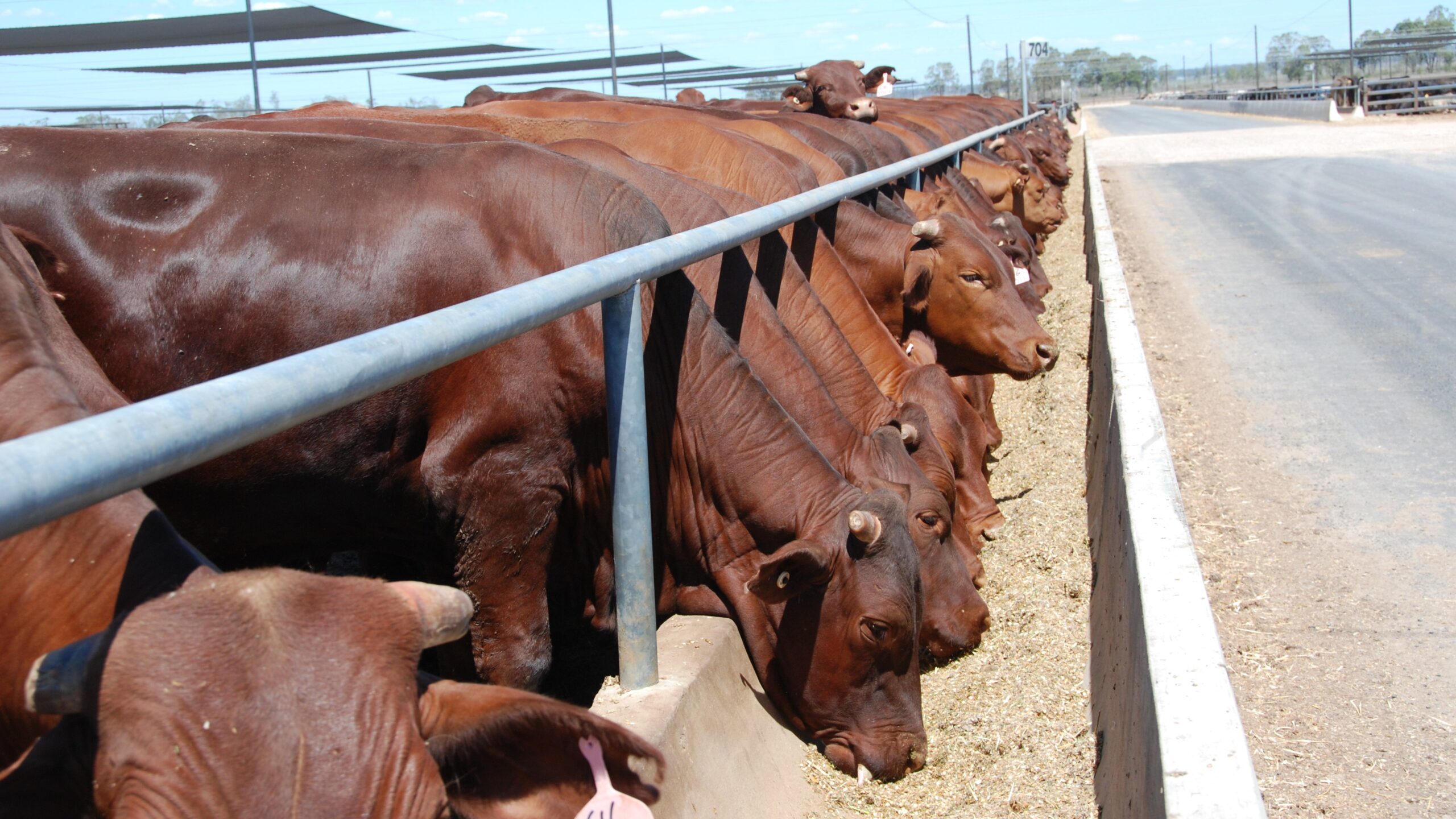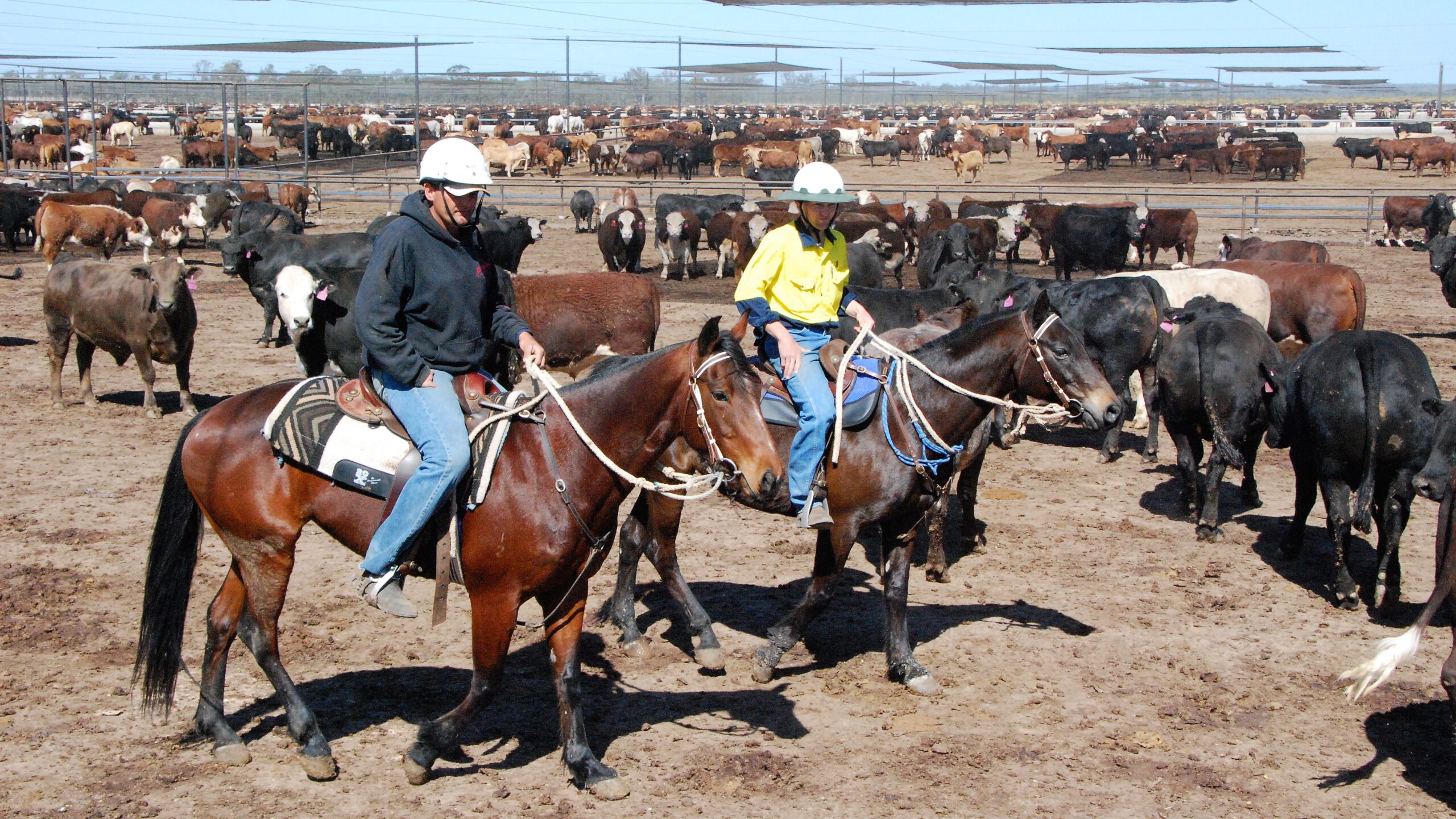What to Consider When Starting a Beef Feedlot
Four distinct factors impact feedlot profitability:
-

Good bunk management is key to high standards of animal welfare and performance and feedlot management. buying price of store cattle
- selling price of finished cattle
- cost of the diet
- cattle performance, as influenced by management.
Each factor is important and requires consideration before commencing a feedlot venture. Feedlot management influences cattle performance through its affect on feed intake, weight gain and herd health.
Feedlot margins are often marginal. This reinforces the value of checking the economics, securing contracts and selecting cattle which perform well and consistently meeting market specifications.
The following is an outline of procedures considered by most well run feedlots from the time of the cattle's arrival until their departure.
On arrival/induction
(a) Cattle arriving at the feedlot are usually tired and uncomfortable in their new surroundings. It is important they are fed and watered as soon as possible with good quality hay and fresh drinking water.
(b) Usually, within a week cattle are inducted into the feedlot by being identified, weighed, vaccinated, drenched and have horns tipped (if required). The use of a growth promotant will depend on company policy and market specifications.
(c) Preventative treatments could include:
- 5 in 1 vaccine to cover clostridial diseases such as enterotoxaemia, tetanus and malignant oedema. Two treatments, four to six weeks apart are necessary.
- Vaccination to cover Bovine Respiratory Disease (BRD)
- In Queensland, cattle arriving from southern states may require treatment for liver fluke
- Lice treatment is required during winter.

The health and welfare of the cattle is part of daily feedlot management.
On going cattle management
(a) Cattle should be observed daily for:
- Signs of disease onset
- feed problems (for example, shy feeders)
- failure to adapt to the diet
- bad 'doers' – it often pays to remove these animals.
(b) Water troughs
- Ample, fresh water is required at all times. Reduced water intake will reduce feed intake and weight gain.
- Water troughs are usually cleaned a minimum of twice a week.
Feed processing
Grain processing is essential. Cracked grain gives approximately 15% better utilisation than whole grain, thereby increasing weight gains and reducing grain wastage. It is best for grain to be coarsely milled, either through a roller mill or hammermill.
Steam flaking of sorghum will further improve its utilisation. Avoid milling the grain too fine as this increases risk of digestive upsets.
Dusty diets can also depress appetite and cause respiratory problems. Small quantities of molasses will increase palatability and reduce dust. Molasses can be fed at up to 10% of the diet.
Introducing cattle to grain: open troughs (or bunks)
Cattle must have grain introduced into their diet gradually. A gradual introduction allows the rumen microbes to adjust to a grain diet thereby minimising the incidence of grain poisoning and laminitis. The following feeding program is a satisfactory method of bringing cattle on to a high grain diet. Cattle should be continually observed during this period for sickness and other health problems. Information regarding diet formulations can be found here.
| % IN DIET | ||
|---|---|---|
| grain and additives | hay | |
| Day 1 to 4 | 20 | 80 |
| Day 5 to 8 | 40 | 60 |
| Day 9 to 12 | 60 | 40 |
| Day 13 to 15 | 80 | 20 |
| Day 16 – | final diet | |
Feeding
It is desirable that cattle are fed at the same time each day to reduce the incidence of metabolic upsets. In wet weather, it may be necessary to feed two to three times a day to avoid feed spoilage/wastage.
It is important that cattle have feed in the troughs at all times. Empty feed troughs are a prime cause of grain poisoning.
Do not feed excessive quantities each day, as the feed may become stale. Try and judge the amount fed so that a little is left over each day. This ensures the cattle are not without feed.
If you have to change grains during the feeding period, it is important that it is done over about a 14-day period. This is particularly important going from sorghum to barley, but not as critical for the reverse.
Introducing cattle to grain: self feeders
Grain intake can be restricted with self feeders by initially using a narrow opening (for example, 12mm) and then gradually raising the shutters over two weeks. Initial mixes are usually 50:50 grain and hay by weight, to assist the mixture to `flow'.
The following method for self feeders has been used successfully in commercial feedlots.
Day 1 to 4: Provide the starter diet in self feeders with a narrow shutter opening. Hay is fed separately in racks. If necessary, place hay on top of the grain in the self feeder trough to attract cattle to the grain.
Day 5 to 7: Gradually increase the daily intake of grain by opening the shutters.
Day 8 to 14: Free access to the starter diet. If mixing your own diet it is preferable to gradually increase the grain percentage of the diet over the next week.
Day 15 on: Free access to the final diet. It is optional as to whether hay feeding in racks continues.

Stocking density
Stocking rates are influenced by rainfall, animal size and class of feedlot, keeping in mind that both dusty and boggy conditions need to be avoided. The National Feedlot Accreditation Scheme generally requires between nine and 25 square metres per Standard Cattle Unit (SCU). A Standard Cattle Unit is defined as an animal of 600kg liveweight, at the time of exit (turn-off) from the feedlot.
For further assistance when considering cattle feedlot stocking densities, contact the Department of Agriculture and Fisheries (DAF) on 13 25 23.
Feed space
Actual space needed varies with ration, cattle size and feeding frequency, however, 20cm per head is the suggested minimum for local trade and Japanese export cattle. The following may be used as a guide:
| Feed troughs (cm/head) | Self feeders (cm/head) | |
|---|---|---|
| Yearling | 25 to 30 | 10 to 20 |
| 18 months to 2 years | 30 to 38 | 20 to 25 |
| Bullocks | 38 to 46 | 25 to 30 |
The feed bunk spacings described above caters for once per day feeding. When feeding is carried out more frequently, the required spacing approaches the self-feeder recommendations.
National Feedlot Accreditation Scheme (NFAS)
Meat marketed with the AUS-MEAT 'grain-fed' description must come from feedlots accredited under the NFAS. This is an industry quality assurance scheme administered by AUS-MEAT. Details of this scheme and associated costs may be obtained from AUS-MEAT telephone 1800 621 903 or email ausmeat@ausmeat.com.au.
Further reading about managing beef cattle feedlots and tools
Refer to other Beef cattle feedlot fact sheets.
- Feed cost calculator – Western Australia Department of Primary Industries and Regional Development
- Costs and nutritive value calculator – NSW Department of Primary Industries
- Drought and supplementary feed calculator – NSW Department of Primary Industries
Further information
Contact the DAF Customer Service Centre on 13 25 23 (Queensland residents) or 07 3404 6999 between 8 am and 6 pm weekdays.
Roger Sneath and Greg Bath, Department of Agriculture and Fisheries.
Source: https://futurebeef.com.au/resources/managing-beef-cattle-feedlots/